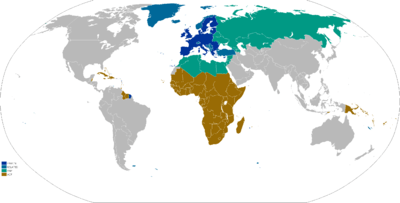Eurosphere

Dark blue: European Union
Light blue: Current enlargement agenda, including all Turkey (97% of the Turkish territory lies in Asia)[note 1] and North American territory Greenland, Autonomous area of Denmark.
Turquoise: European Neighbourhood: the rest of Europe, including all Russia (25% of Russia lies within Europe, occupying 40% of Europe's landmass; 78% of all Russians live in European Russia) and the countries outside Europe closely related to the European Union
Brown: ACP countries
The concept of the ‘Eurosphere’ or ‘European Empire[1]’ has grown in popularity in the early years of the 21st century, and is associated with the public intellectual Mark Leonard,[2] the academic at the University of Oxford, Jan Zielonka,[1] the academic at Georgetown University, Josep Colomer,[3] the strategist and European Union Director-General for Politico-Military Affairs, Robert Cooper;[4] and the President of the European Commission, José Manuel Barroso.[5]
Over the past 50 years, the European Union has expanded from the 6 founding members to 28, there are 8 candidate and potential candidate countries waiting to join. A number of western European countries are integrated economically, as part of the Union's single market or using its single currency. Through its High Representative of the Union for Foreign Affairs and Security Policy it has a capability to speak with one voice in the world and has association and free trade agreements with a large number of states, through the European Neighbourhood Policy and Union for the Mediterranean (developed from the Barcelona process) it is creating closer ties with those countries on its borders, while developed ties with former colonies, now the ACP countries.
Membership in particular has seen a great deal of reform in countries seeking to join; for example the huge reforms seen in Turkey such as the abolition of capital punishment.[6] The development of the Union's influence, and the draw of membership, has been the subject of a number of academic writings. For example Mark Leonard describes the area of EU influence as the Eurosphere.
Countries within the Eurosphere
According to Mark Leonard, the Eurosphere includes (what were in 2004) 109 countries. In Europe, these were the then-25 members, applicant countries, western Balkan countries and European CIS countries (including transcontinental countries such as Kazakhstan). Curiously he does not mention western European countries such as Norway who are integrated into the EU's single market. Outside Europe, he gives a blanket list of every African country and every Middle Eastern country, that is so the countries forming the eastern border of the Eurosphere are Iran, Azerbaijan, Russia and Kazakhstan.[7]
Other countries that could be said to be within the Eurosphere might include western European countries, such as those in the European Economic Area or using the euro, or the Union's overseas territories. Both these groups have strong economic links, through the afore mentioned relationships.
Quotes
| “ | The postmodern, European answer to threats is to extend the system of co-operative empire ever wider. "I have no way to defend my borders but to extend them", said Catherine the Great—and the European Union sometimes seems to be saying the same. | ” |
| —Robert Cooper, 2003 | ||
| “ | But the next wave of European transformation is only just beginning. The European Union is starting to develop an enormous sphere of influence, extending way beyond its borders, that could be called the "Eurosphere". This belt of eighty countries covering the former Soviet Union, the Western Balkans, the Middle East, North Africa, and Sub-Saharan Africa accounts for 20 per cent of the world's population. | ” |
| —Mark Leonard, 2005 | ||
| “ | What we have is the first non-imperial empire...We have twenty-seven countries that fully decided to work together and to pool their sovereignty. I believe it is a great construction and we should be proud of it. | ” |
| —José Manuel Barroso, 2007 | ||
See also
- ECHO (European Commission)
- ACP-EU Development Cooperation
- ACP-EU Joint Parliamentary Assembly
- EU-ACP Economic Partnership Agreements
- ACP-EU Development Cooperation
- Enlargement of the European Union
- European integration
- European Neighbourhood Policy
- Barcelona Process
- Euro-Mediterranean Parliamentary Assembly
- Mediterranean Union
- Barcelona Process
- European Union as a potential superpower
- Foreign relations of the European Union
- Multi-speed Europe
- United States of Europe
Notes and References
- ↑ Geographically, Turkey is only partly in Europe with 3 percent of its territory; it has 97 percent of its territory in Asia. Geography of Turkey
- ↑ 1.0 1.1 Zielonka, J. (2006), Europe as Empire, Oxford University Press: Oxford.
- ↑ Leonard, M. (2005), Why Europe will run the 21st century, Fourth Estate: London.
- ↑ Colomer, J. (2007), Great Empires, Small Nations, Routledge: London.
- ↑ Cooper, R. (2003), The Breaking of Nations, Atlantic Books: London.
- ↑ http://www.globalpowereurope.eu/2007/07/birth-of-new-rome.html
- ↑ EU-Turkey relations euractiv.com
- ↑ Leonard, M. Why Europe will run the 21st century (2004, Fourth Estate). Appendix: p.145-146.
Further reading
- Ankerl, Guy (2000). Global communication without universal civilization. INU societal research. Vol.1: Coexisting contemporary civilizations : Arabo-Muslim, Bharati, Chinese, and Western. Geneva: INU Press. ISBN 2-88155-004-5.
External links
- "The EU as a Regional Normative Hegemon: The Case of European Neighbourhood Policy"
- Mahony, Honor (2007-07-11) Barroso says EU is an 'empire' EU Observer.
| ||||||||||||||||||||||
| ||||||||||||||||||||||||||||||||||||||||||||||||||||||||||||||||||||
| ||||||||||||||||||||||||||||||||||||||||||||||||||||||||||||||